The Inscape Environment
environment英语作文
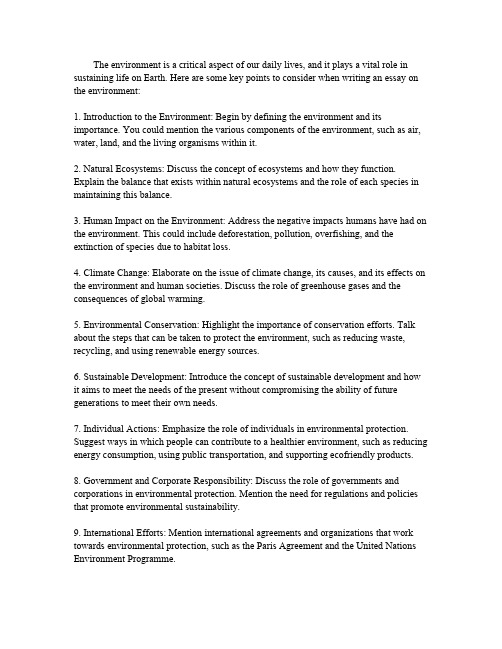
The environment is a critical aspect of our daily lives,and it plays a vital role in sustaining life on Earth.Here are some key points to consider when writing an essay on the environment:1.Introduction to the Environment:Begin by defining the environment and its importance.You could mention the various components of the environment,such as air, water,land,and the living organisms within it.2.Natural Ecosystems:Discuss the concept of ecosystems and how they function. Explain the balance that exists within natural ecosystems and the role of each species in maintaining this balance.3.Human Impact on the Environment:Address the negative impacts humans have had on the environment.This could include deforestation,pollution,overfishing,and the extinction of species due to habitat loss.4.Climate Change:Elaborate on the issue of climate change,its causes,and its effects on the environment and human societies.Discuss the role of greenhouse gases and the consequences of global warming.5.Environmental Conservation:Highlight the importance of conservation efforts.Talk about the steps that can be taken to protect the environment,such as reducing waste, recycling,and using renewable energy sources.6.Sustainable Development:Introduce the concept of sustainable development and how it aims to meet the needs of the present without compromising the ability of future generations to meet their own needs.7.Individual Actions:Emphasize the role of individuals in environmental protection. Suggest ways in which people can contribute to a healthier environment,such as reducing energy consumption,using public transportation,and supporting ecofriendly products. ernment and Corporate Responsibility:Discuss the role of governments and corporations in environmental protection.Mention the need for regulations and policies that promote environmental sustainability.9.International Efforts:Mention international agreements and organizations that work towards environmental protection,such as the Paris Agreement and the United Nations Environment Programme.10.Conclusion:Conclude your essay by summarizing the main points and emphasizing the urgency of environmental protection.Encourage readers to take action and contribute to the preservation of the environment.Remember to use clear and concise language,provide examples to support your points, and cite credible sources if necessary.Writing an essay on the environment is an opportunity to raise awareness and inspire action towards a more sustainable future.。
海洋生态系统 英语作文
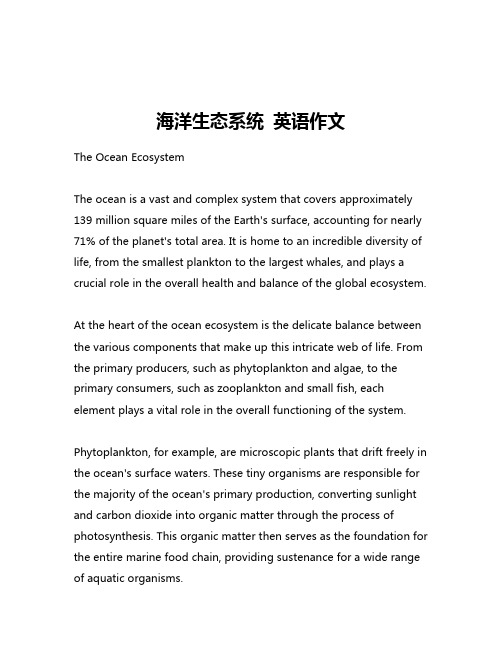
海洋生态系统英语作文The Ocean EcosystemThe ocean is a vast and complex system that covers approximately 139 million square miles of the Earth's surface, accounting for nearly 71% of the planet's total area. It is home to an incredible diversity of life, from the smallest plankton to the largest whales, and plays a crucial role in the overall health and balance of the global ecosystem.At the heart of the ocean ecosystem is the delicate balance between the various components that make up this intricate web of life. From the primary producers, such as phytoplankton and algae, to the primary consumers, such as zooplankton and small fish, each element plays a vital role in the overall functioning of the system.Phytoplankton, for example, are microscopic plants that drift freely in the ocean's surface waters. These tiny organisms are responsible for the majority of the ocean's primary production, converting sunlight and carbon dioxide into organic matter through the process of photosynthesis. This organic matter then serves as the foundation for the entire marine food chain, providing sustenance for a wide range of aquatic organisms.Zooplankton, on the other hand, are small animals that also drift freely in the ocean. These creatures, which include tiny crustaceans, larvae, and other small invertebrates, feed on the phytoplankton and serve as a crucial link between the primary producers and the higher trophic levels of the food chain.As the zooplankton are consumed by larger predators, such as small fish and filter-feeding whales, the energy and nutrients that were initially captured by the phytoplankton are transferred up the food chain. This process, known as the biological pump, is essential for the overall health and productivity of the ocean ecosystem.In addition to the primary producers and consumers, the ocean ecosystem is also home to a diverse array of other organisms, including coral reefs, kelp forests, and deep-sea hydrothermal vents. Each of these unique ecosystems plays a crucial role in the overall functioning of the ocean, providing habitat, food, and other essential resources for a wide range of marine life.Coral reefs, for example, are often referred to as the "rainforests of the sea" due to their incredible biodiversity. These underwater structures are built by colonies of tiny marine invertebrates, known as coral polyps, and provide a home for thousands of species of fish, invertebrates, and other marine life.Kelp forests, on the other hand, are large underwater forests of brown algae that can grow to heights of over 100 feet. These ecosystems provide critical habitat and food resources for a wide range of marine organisms, including sea otters, sea lions, and a variety of fish species.Deep-sea hydrothermal vents, meanwhile, are unique ecosystems that are found at the bottom of the ocean, often in areas where tectonic plates are spreading apart. These vents release superheated, mineral-rich water that supports a diverse community of specialized organisms, including tubeworms, shrimp, and a variety of other unique and often previously undiscovered species.Despite the incredible diversity and importance of the ocean ecosystem, it is facing a number of significant threats, including overfishing, pollution, climate change, and habitat destruction. Overfishing, for example, has led to the depletion of many commercially important fish species, disrupting the delicate balance of the food chain and threatening the overall health of the ecosystem.Pollution, including plastic waste, oil spills, and the release of harmful chemicals and nutrients, can also have devastating effects on the ocean ecosystem, harming or even killing a wide range of marineorganisms and disrupting the overall functioning of the system.Climate change, meanwhile, is having a profound impact on the ocean, with rising temperatures, ocean acidification, and changes in ocean currents and upwelling patterns all contributing to significant changes in the marine environment. These changes can have far-reaching consequences for the entire ocean ecosystem, affecting everything from the distribution and abundance of marine species to the overall productivity and resilience of the system.In order to address these threats and ensure the long-term health and sustainability of the ocean ecosystem, it is essential that we take action to protect and conserve this vital resource. This can involve a range of strategies, including sustainable fishing practices, the establishment of marine protected areas, the reduction of pollution and waste, and the implementation of policies and regulations that promote the conservation and restoration of marine habitats.By working together to protect and preserve the ocean ecosystem, we can not only ensure the continued health and well-being of the marine environment, but also safeguard the countless benefits that the ocean provides to human societies around the world. From the provision of food and resources to the regulation of global climate and the support of diverse and vibrant coastal communities, theocean is a truly invaluable and irreplaceable component of our planet's overall ecosystem.。
英语作文:保护环境 Protecting the Environment
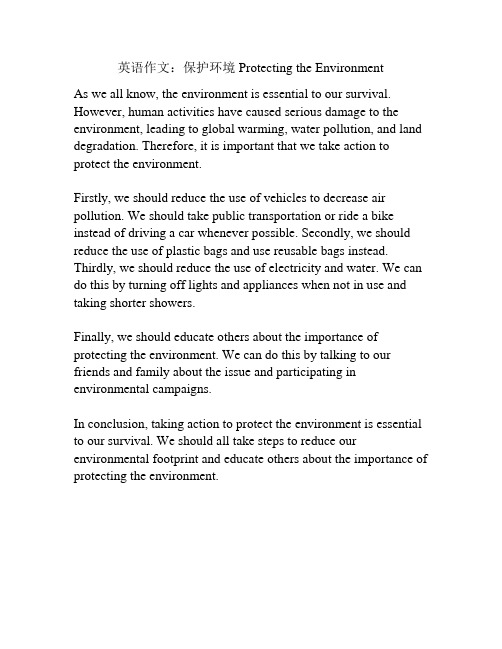
英语作文:保护环境 Protecting the EnvironmentAs we all know, the environment is essential to our survival. However, human activities have caused serious damage to the environment, leading to global warming, water pollution, and land degradation. Therefore, it is important that we take action to protect the environment.Firstly, we should reduce the use of vehicles to decrease air pollution. We should take public transportation or ride a bike instead of driving a car whenever possible. Secondly, we should reduce the use of plastic bags and use reusable bags instead. Thirdly, we should reduce the use of electricity and water. We can do this by turning off lights and appliances when not in use and taking shorter showers.Finally, we should educate others about the importance of protecting the environment. We can do this by talking to our friends and family about the issue and participating in environmental campaigns.In conclusion, taking action to protect the environment is essential to our survival. We should all take steps to reduce our environmental footprint and educate others about the importance of protecting the environment.。
保护森林爱护环境的英语作文300
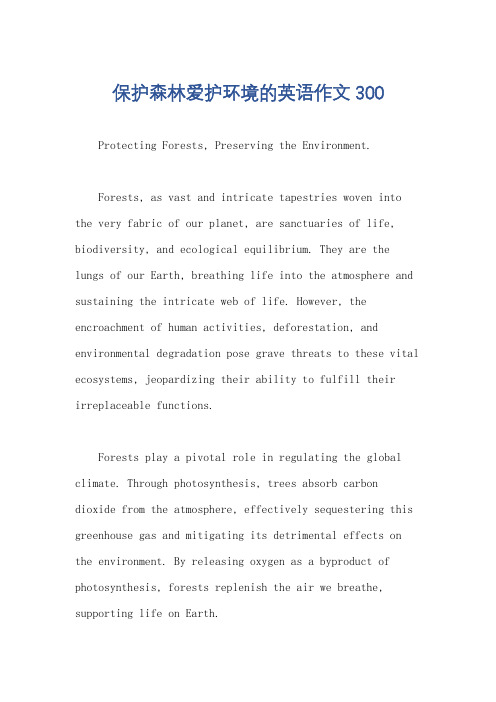
保护森林爱护环境的英语作文300Protecting Forests, Preserving the Environment.Forests, as vast and intricate tapestries woven into the very fabric of our planet, are sanctuaries of life, biodiversity, and ecological equilibrium. They are the lungs of our Earth, breathing life into the atmosphere and sustaining the intricate web of life. However, the encroachment of human activities, deforestation, and environmental degradation pose grave threats to these vital ecosystems, jeopardizing their ability to fulfill their irreplaceable functions.Forests play a pivotal role in regulating the global climate. Through photosynthesis, trees absorb carbon dioxide from the atmosphere, effectively sequestering this greenhouse gas and mitigating its detrimental effects on the environment. By releasing oxygen as a byproduct of photosynthesis, forests replenish the air we breathe, supporting life on Earth.Apart from their role in climate regulation, forests provide invaluable ecosystem services. They are watersheds, capturing rainwater and releasing it gradually into streams and rivers, ensuring a steady water supply for human populations and ecosystems alike. Forests also serve as natural guardians against erosion, their dense root systems binding the soil and preventing its loss to wind and water.Forests are havens of biodiversity, housing an astonishing array of plant and animal species. They provide habitat, food, and shelter for countless organisms, from towering trees to microscopic organisms. The intricate interdependencies within forest ecosystems contribute to their resilience and stability.However, these invaluable ecosystems are under immense pressure from human activities. Deforestation, driven by urbanization, agriculture, and resource extraction, is a major threat. The loss of forests not only diminishes their ecological functions but also releases significant amounts of carbon dioxide into the atmosphere, exacerbating climatechange.Other environmental degradation factors also endanger forests. Air pollution, acid rain, and invasive species can weaken trees and disrupt forest ecosystems. Unsustainable harvesting practices, such as clear-cutting, can also lead to forest degradation and loss.Protecting forests is not merely an environmental imperative; it is an investment in our future. By safeguarding these precious ecosystems, we preserve the services they provide, ensuring a healthy and sustainable planet for ourselves and generations to come.Efforts to protect forests require a multifaceted approach, involving governments, industries, andindividuals alike. Sustainable forest management practices, such as selective logging and reforestation, are crucial. Reducing our consumption of forest products, opting for alternatives like recycled paper and sustainably sourced timber, can also help alleviate pressure on forests.International cooperation is essential to combat deforestation. Initiatives like the United Nations Framework Convention on Climate Change and the Global Environment Facility provide a platform for nations to collaborate on forest conservation efforts. By working together, we can strengthen laws and policies that protect forests and hold corporations accountable for their environmental impact.On a local level, community engagement and education are vital. Raising awareness about the importance offorests and empowering local communities to participate in conservation efforts can create a sense of ownership and stewardship. By involving indigenous communities, who often possess deep knowledge of forest ecosystems, we can ensure that conservation efforts are culturally sensitive and sustainable.Protecting forests requires a shift in our relationship with nature. We must move beyond viewing forests as mere commodities to be exploited and embrace them as irreplaceable allies in our quest for a healthy andsustainable future. By investing in forest conservation, we are investing in our own well-being and the well-being of generations to come.In the words of the conservationist Baba Dioum, "In the end, we will conserve only what we love, we will love only what we understand, and we will understand only what we are taught." Let us, therefore, strive to understand the immeasurable value of forests and to teach future generations the importance of their preservation. By working together, we can protect these vital ecosystems and ensure a sustainable future for our planet.。
作文如何保护生态环境英语
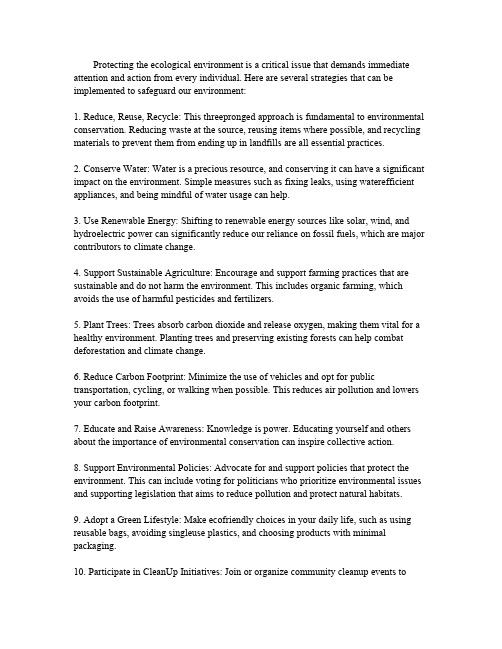
Protecting the ecological environment is a critical issue that demands immediate attention and action from every individual.Here are several strategies that can be implemented to safeguard our environment:1.Reduce,Reuse,Recycle:This threepronged approach is fundamental to environmental conservation.Reducing waste at the source,reusing items where possible,and recycling materials to prevent them from ending up in landfills are all essential practices.2.Conserve Water:Water is a precious resource,and conserving it can have a significant impact on the environment.Simple measures such as fixing leaks,using waterefficient appliances,and being mindful of water usage can help.e Renewable Energy:Shifting to renewable energy sources like solar,wind,and hydroelectric power can significantly reduce our reliance on fossil fuels,which are major contributors to climate change.4.Support Sustainable Agriculture:Encourage and support farming practices that are sustainable and do not harm the environment.This includes organic farming,which avoids the use of harmful pesticides and fertilizers.5.Plant Trees:Trees absorb carbon dioxide and release oxygen,making them vital for a healthy environment.Planting trees and preserving existing forests can help combat deforestation and climate change.6.Reduce Carbon Footprint:Minimize the use of vehicles and opt for public transportation,cycling,or walking when possible.This reduces air pollution and lowers your carbon footprint.cate and Raise Awareness:Knowledge is cating yourself and others about the importance of environmental conservation can inspire collective action.8.Support Environmental Policies:Advocate for and support policies that protect the environment.This can include voting for politicians who prioritize environmental issues and supporting legislation that aims to reduce pollution and protect natural habitats. 9.Adopt a Green Lifestyle:Make ecofriendly choices in your daily life,such as using reusable bags,avoiding singleuse plastics,and choosing products with minimal packaging.10.Participate in CleanUp Initiatives:Join or organize community cleanup events toremove litter and waste from local parks,beaches,and other natural areas.11.Monitor and Report Environmental Violations:Be vigilant about environmental violations in your community and report them to the appropriate authorities.12.Promote Biodiversity:Support initiatives that protect and enhance biodiversity,such as wildlife conservation projects and habitat restoration efforts.By incorporating these practices into our daily lives,we can collectively work towards a healthier and more sustainable environment for future generations.。
生态环境的英语作文
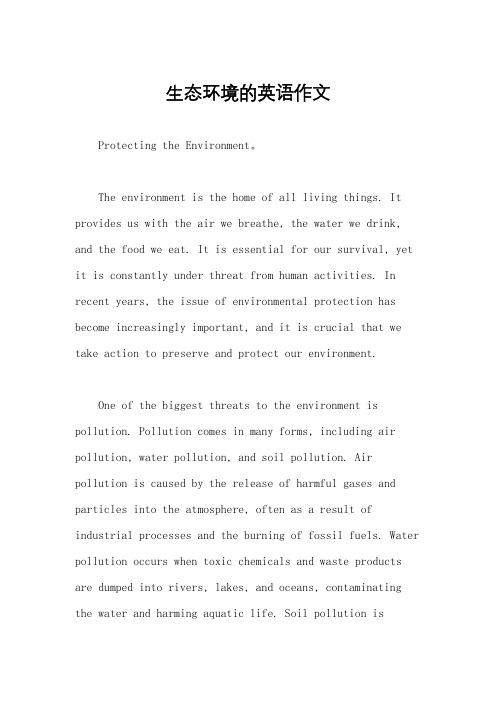
生态环境的英语作文Protecting the Environment。
The environment is the home of all living things. It provides us with the air we breathe, the water we drink, and the food we eat. It is essential for our survival, yet it is constantly under threat from human activities. In recent years, the issue of environmental protection has become increasingly important, and it is crucial that we take action to preserve and protect our environment.One of the biggest threats to the environment is pollution. Pollution comes in many forms, including air pollution, water pollution, and soil pollution. Air pollution is caused by the release of harmful gases and particles into the atmosphere, often as a result of industrial processes and the burning of fossil fuels. Water pollution occurs when toxic chemicals and waste products are dumped into rivers, lakes, and oceans, contaminating the water and harming aquatic life. Soil pollution iscaused by the use of pesticides and other chemicals in agriculture, which can have a detrimental impact on the health of the soil and the plants that grow in it.Another major threat to the environment is deforestation. Trees are essential for maintaining the balance of oxygen and carbon dioxide in the atmosphere, yet millions of acres of forest are cut down every year to make way for agriculture, urban development, and other human activities. This not only contributes to climate change but also destroys the habitats of countless species of plants and animals.Climate change is another significant issue that is having a profound impact on the environment. The burning of fossil fuels and the release of greenhouse gases into the atmosphere are causing the Earth's temperature to rise, leading to more frequent and severe weather events, rising sea levels, and other negative consequences. If we do not take action to reduce our carbon footprint and mitigate the effects of climate change, the consequences could be catastrophic.In order to protect the environment, it is essential that we take action at both an individual and a collective level. There are many things that we can do in our daily lives to reduce our impact on the environment. For example, we can reduce our energy consumption by using energy-efficient appliances, turning off lights and electronics when not in use, and using public transportation or carpooling instead of driving alone. We can also reduce our waste by recycling and composting, and by using reusable products instead of single-use items.At a collective level, governments and organizations must also take action to protect the environment. This can include implementing and enforcing regulations to limit pollution, investing in renewable energy sources, and preserving natural habitats through the creation ofnational parks and other protected areas. It is also important for businesses to adopt sustainable practices and to take responsibility for the environmental impact oftheir operations.In conclusion, protecting the environment is essential for the well-being of all living things. We must take action to reduce pollution, prevent deforestation, and mitigate the effects of climate change in order to preserve the natural world for future generations. By making changes in our daily lives and advocating for policies that protect the environment, we can work together to create a healthier and more sustainable planet.。
保护生态英文作文
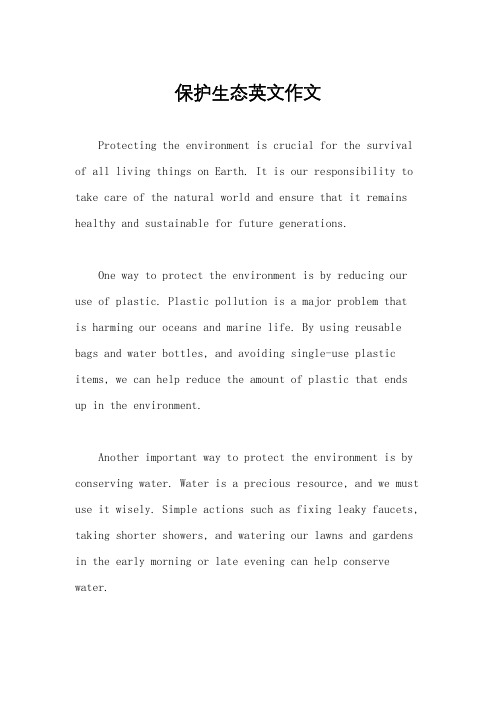
保护生态英文作文Protecting the environment is crucial for the survival of all living things on Earth. It is our responsibility to take care of the natural world and ensure that it remains healthy and sustainable for future generations.One way to protect the environment is by reducing our use of plastic. Plastic pollution is a major problem that is harming our oceans and marine life. By using reusable bags and water bottles, and avoiding single-use plastic items, we can help reduce the amount of plastic that ends up in the environment.Another important way to protect the environment is by conserving water. Water is a precious resource, and we must use it wisely. Simple actions such as fixing leaky faucets, taking shorter showers, and watering our lawns and gardens in the early morning or late evening can help conserve water.We can also protect the environment by reducing our energy consumption. Using energy-efficient appliances, turning off lights and electronics when not in use, and carpooling or using public transportation are all ways to reduce our carbon footprint and lessen the impact on the environment.Protecting natural habitats is essential for preserving biodiversity. Deforestation, urbanization, and pollution are all threats to natural habitats and the species that depend on them. By supporting conservation efforts and sustainable land use practices, we can help protect the diverse ecosystems that exist around the world.In conclusion, protecting the environment is a collective effort that requires individual actions as well as global cooperation. By making simple changes to ourdaily lives and supporting initiatives that aim to preserve the natural world, we can all contribute to a healthier and more sustainable planet.。
人与自然沙漠的环境英语作文
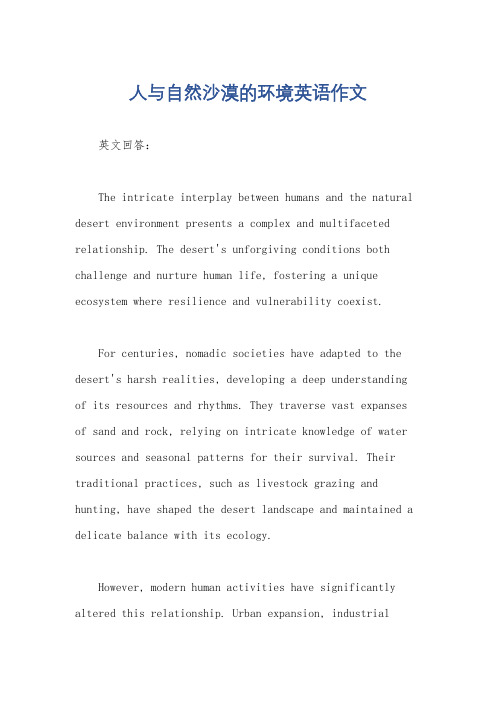
人与自然沙漠的环境英语作文英文回答:The intricate interplay between humans and the natural desert environment presents a complex and multifaceted relationship. The desert's unforgiving conditions both challenge and nurture human life, fostering a unique ecosystem where resilience and vulnerability coexist.For centuries, nomadic societies have adapted to the desert's harsh realities, developing a deep understanding of its resources and rhythms. They traverse vast expanses of sand and rock, relying on intricate knowledge of water sources and seasonal patterns for their survival. Their traditional practices, such as livestock grazing and hunting, have shaped the desert landscape and maintained a delicate balance with its ecology.However, modern human activities have significantly altered this relationship. Urban expansion, industrialdevelopment, and mass tourism have encroached upon delicate desert ecosystems, leading to habitat fragmentation, pollution, and overexploitation of resources. Rapid urbanization has led to the loss of vast tracts of desert land, while industrial activities have introduced toxic substances into the fragile environment. Mass tourism,while providing economic benefits, can also lead to degradation of fragile ecosystems and disruption of the natural balance.The desert's unique flora and fauna have evolved remarkable adaptations to survive in its extreme conditions. Desert plants have developed specialized structures to conserve water, such as succulent leaves and deep root systems. Animals have adapted to extreme temperatures, limited water availability, and the scarcity of food resources. The interdependence of these organisms creates a complex web of ecological relationships that contributes to the stability of the desert ecosystem.However, human activities have threatened this delicate balance. Overgrazing by livestock, habitat destruction, andthe introduction of invasive species have disrupted the delicate balance of the desert ecosystem. Climate change is also posing significant challenges, with increased temperatures and reduced precipitation putting stress on desert organisms and making the environment less hospitable to human habitation.To preserve the delicate relationship between humans and the desert environment, it is crucial to implement sustainable practices and policies. Conservation efforts must prioritize the protection of critical habitats, the restoration of degraded lands, and the reduction of pollution. Promoting ecotourism and responsible resource management can help mitigate the negative impacts of human activities while supporting local communities.Furthermore, it is essential to foster a deeper understanding of the desert ecosystem and its importancefor both human and natural communities. Educational initiatives and awareness campaigns can help raise awareness about the fragility of the desert and the needfor its preservation. By working together, we can protectand preserve this unique and valuable environment for future generations.中文回答:人与自然沙漠的环境。
播放生态环境的作文英语
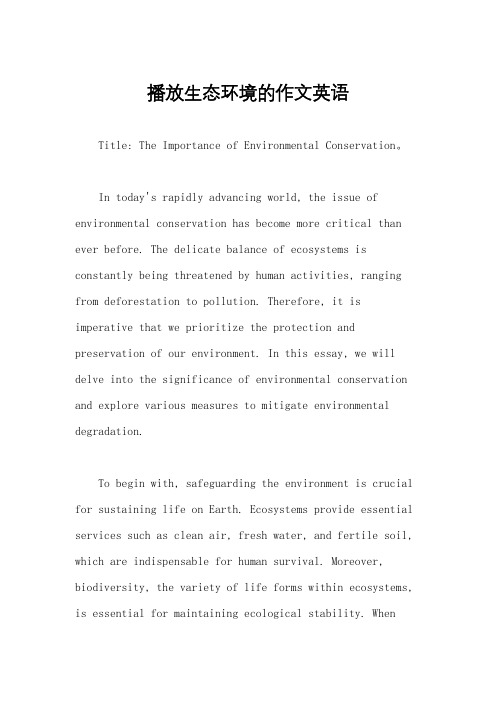
播放生态环境的作文英语Title: The Importance of Environmental Conservation。
In today's rapidly advancing world, the issue of environmental conservation has become more critical than ever before. The delicate balance of ecosystems is constantly being threatened by human activities, ranging from deforestation to pollution. Therefore, it is imperative that we prioritize the protection and preservation of our environment. In this essay, we will delve into the significance of environmental conservation and explore various measures to mitigate environmental degradation.To begin with, safeguarding the environment is crucial for sustaining life on Earth. Ecosystems provide essential services such as clean air, fresh water, and fertile soil, which are indispensable for human survival. Moreover, biodiversity, the variety of life forms within ecosystems, is essential for maintaining ecological stability. Whenbiodiversity is compromised, ecosystems become vulnerable to collapse, leading to adverse consequences for both humans and wildlife.Furthermore, environmental conservation is essentialfor mitigating climate change. The burning of fossil fuels and deforestation release greenhouse gases into the atmosphere, contributing to global warming. This, in turn, leads to rising sea levels, extreme weather events, and disruptions in agricultural patterns. By implementing sustainable practices such as renewable energy adoption and reforestation, we can reduce our carbon footprint and mitigate the impacts of climate change.In addition to its ecological significance, environmental conservation also has social and economic implications. Healthy ecosystems support livelihoods and provide valuable resources such as food, medicine, and raw materials. Moreover, ecotourism, which relies on pristine natural environments, generates revenue and creates employment opportunities for local communities. By preserving natural habitats and promoting sustainabledevelopment, we can ensure the well-being of both present and future generations.Despite the importance of environmental conservation, the current state of our planet is alarming. Deforestation, pollution, and habitat destruction are rampant, threatening the integrity of ecosystems worldwide. Therefore, urgent action is needed to address these pressing environmental issues. Governments, corporations, and individuals all have a role to play in promoting sustainability and protecting the environment.Governments can enact policies and regulations to curb environmental degradation and promote conservation efforts. This may include implementing carbon pricing mechanisms, enforcing stricter pollution controls, and establishing protected areas for biodiversity conservation. Furthermore, international cooperation is essential for addressing transboundary environmental challenges such as air and water pollution.Corporations also have a responsibility to minimizetheir environmental impact and adopt sustainable business practices. This may involve investing in clean technologies, reducing waste generation, and incorporating environmental considerations into supply chain management. Byprioritizing sustainability, businesses can not onlymitigate environmental risks but also enhance their long-term competitiveness and reputation.At the individual level, each of us can contribute to environmental conservation through simple yet impactful actions. This may include reducing energy consumption, conserving water, minimizing waste, and supporting eco-friendly products and services. Moreover, raising awareness about environmental issues and advocating for policy changes can amplify our collective impact and drivepositive change.In conclusion, environmental conservation is of paramount importance for the well-being of both humans and the planet. By preserving ecosystems, mitigating climate change, and promoting sustainable development, we canensure a brighter and more sustainable future forgenerations to come. However, achieving this goal requires concerted efforts from governments, corporations, and individuals alike. Only through collective action and shared responsibility can we safeguard our planet for future generations.。
现在的生态环境的英语作文
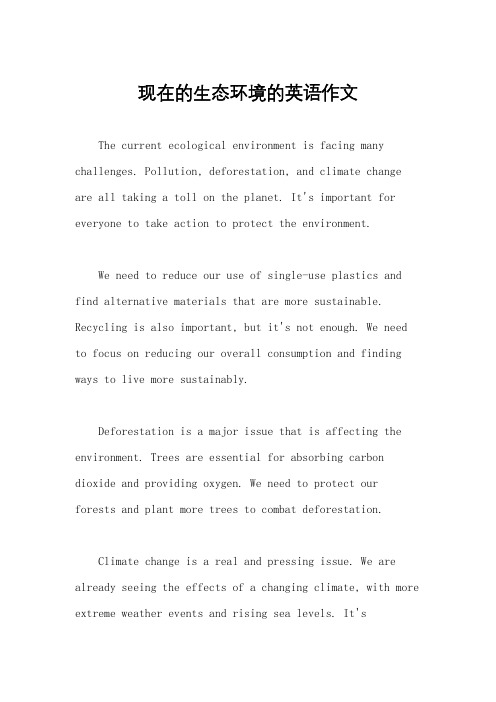
现在的生态环境的英语作文The current ecological environment is facing many challenges. Pollution, deforestation, and climate change are all taking a toll on the planet. It's important for everyone to take action to protect the environment.We need to reduce our use of single-use plastics and find alternative materials that are more sustainable. Recycling is also important, but it's not enough. We need to focus on reducing our overall consumption and finding ways to live more sustainably.Deforestation is a major issue that is affecting the environment. Trees are essential for absorbing carbon dioxide and providing oxygen. We need to protect ourforests and plant more trees to combat deforestation.Climate change is a real and pressing issue. We are already seeing the effects of a changing climate, with more extreme weather events and rising sea levels. It'simportant for us to reduce our carbon footprint and transition to renewable energy sources.Protecting biodiversity is crucial for the health of the planet. We need to protect endangered species and their habitats. It's important to recognize the interconnectedness of all living things and work to preserve the diversity of life on Earth.It's up to all of us to take action to protect the environment. We need to make changes in our daily lives and support policies that promote environmental protection. The health of the planet is in our hands, and we need to act now to ensure a sustainable future.。
正在进行时的英语作文
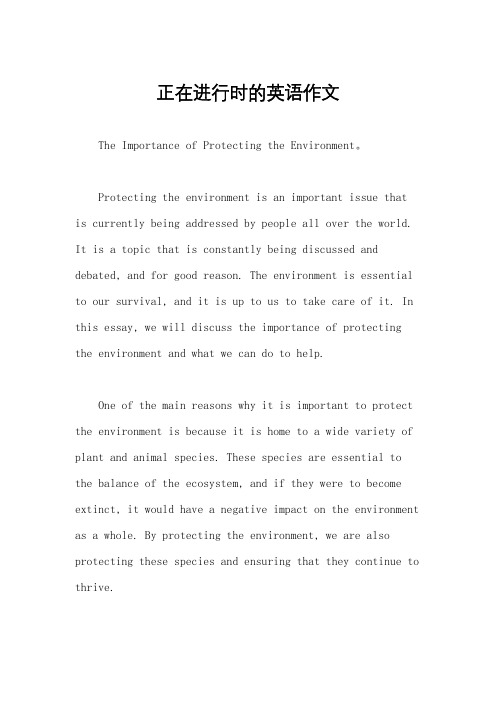
正在进行时的英语作文The Importance of Protecting the Environment。
Protecting the environment is an important issue thatis currently being addressed by people all over the world. It is a topic that is constantly being discussed and debated, and for good reason. The environment is essential to our survival, and it is up to us to take care of it. In this essay, we will discuss the importance of protecting the environment and what we can do to help.One of the main reasons why it is important to protect the environment is because it is home to a wide variety of plant and animal species. These species are essential to the balance of the ecosystem, and if they were to become extinct, it would have a negative impact on the environment as a whole. By protecting the environment, we are also protecting these species and ensuring that they continue to thrive.Another reason why it is important to protect the environment is because it directly affects our health. Pollution and other environmental issues can have anegative impact on our health, leading to respiratory problems, allergies, and other health issues. By protecting the environment, we are also protecting ourselves and our loved ones.Additionally, protecting the environment is importantfor future generations. If we do not take care of the environment now, future generations will suffer the consequences. It is our responsibility to ensure that the environment is in good condition for our children and grandchildren.There are many things that we can do to help protectthe environment. One of the most important things is to reduce our carbon footprint. This can be done by usingpublic transportation, walking or biking instead of driving, and using energy-efficient appliances. We can also reduce our waste by recycling and using reusable products.Another important way to protect the environment is to support organizations and initiatives that are working to protect the environment. This can be done by donating money, volunteering, or simply spreading awareness about the importance of protecting the environment.In conclusion, protecting the environment is an important issue that is currently being addressed by people all over the world. It is essential to our survival, and it is up to us to take care of it. By protecting the environment, we are also protecting ourselves, future generations, and the wide variety of plant and animal species that call the environment home. There are manythings that we can do to help protect the environment, andit is important that we all do our part.。
现在的生态环境的英语作文
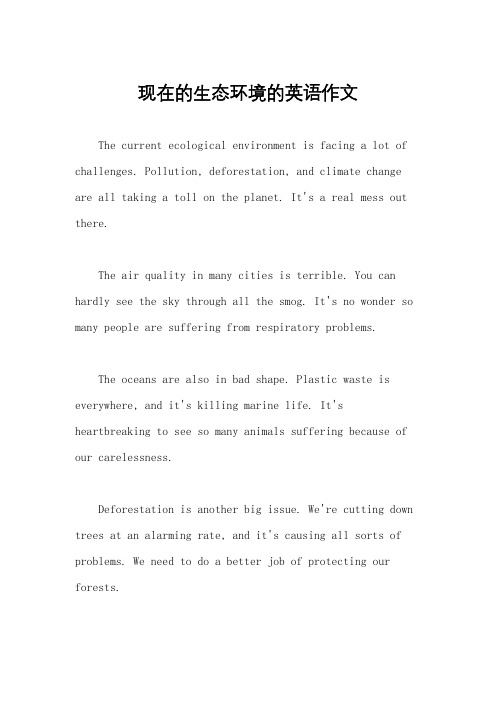
现在的生态环境的英语作文The current ecological environment is facing a lot of challenges. Pollution, deforestation, and climate change are all taking a toll on the planet. It's a real mess out there.The air quality in many cities is terrible. You can hardly see the sky through all the smog. It's no wonder so many people are suffering from respiratory problems.The oceans are also in bad shape. Plastic waste is everywhere, and it's killing marine life. It's heartbreaking to see so many animals suffering because of our carelessness.Deforestation is another big issue. We're cutting down trees at an alarming rate, and it's causing all sorts of problems. We need to do a better job of protecting our forests.And then there's climate change. It's causing extreme weather events all over the world. It seems like there's a new natural disaster happening every other day.But it's not all doom and gloom. There are people out there who are working hard to protect the environment.They're coming up with innovative solutions to the problems we're facing.We all need to do our part to protect the planet. Wecan start by reducing our use of plastic, conserving energy, and supporting organizations that are working to make the world a better place. It's going to take a collectiveeffort to turn things around, but it's definitely possible.。
关于生态保护的作文英文
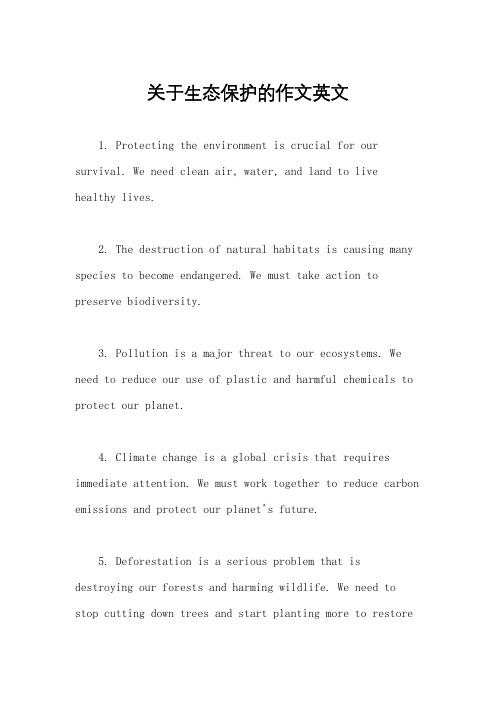
关于生态保护的作文英文1. Protecting the environment is crucial for our survival. We need clean air, water, and land to live healthy lives.2. The destruction of natural habitats is causing many species to become endangered. We must take action to preserve biodiversity.3. Pollution is a major threat to our ecosystems. We need to reduce our use of plastic and harmful chemicals to protect our planet.4. Climate change is a global crisis that requires immediate attention. We must work together to reduce carbon emissions and protect our planet's future.5. Deforestation is a serious problem that is destroying our forests and harming wildlife. We need to stop cutting down trees and start planting more to restorebalance.6. Sustainable practices are essential for the long-term health of our planet. We must support eco-friendly initiatives and businesses to create a more sustainable future.7. Education is key to promoting environmental awareness and action. We need to teach future generations about the importance of protecting our planet.8. Every individual has a role to play in protecting the environment. We can all make small changes in our daily lives to reduce our impact on the planet.。
对环境的察觉英语作文

对环境的察觉英语作文The first thing I notice when I step outside is the fresh air hitting my face, carrying with it the scent of pine trees and damp earth. It's a reminder of the natural world surrounding me, even in the midst of the city.As I walk down the street, I can't help but notice the litter scattered along the sidewalk. It's a stark contrast to the beauty of the trees and flowers lining the road. I feel a pang of sadness at the thoughtlessness of those who would desecrate such a peaceful environment.Looking up, I see the sky stretching out above me, a vast expanse of blue interrupted only by fluffy white clouds. It's a sight that never fails to make me feel small and insignificant in the grand scheme of things.Passing by a park, I hear the chirping of birds and the rustling of leaves in the wind. It's a symphony of nature that brings a smile to my face and a sense of peace to myheart.As I continue on my way, I notice the sound of cars honking and engines roaring, a harsh reminder of the urban jungle that surrounds me. It's a cacophony that threatens to drown out the beauty of the natural world if I let it.Finally, as I reach my destination, I take a moment to look around and appreciate the beauty of the world we live in. Despite the chaos and pollution, there is still so much to be grateful for in the environment around us.。
生态环境相关英文作文
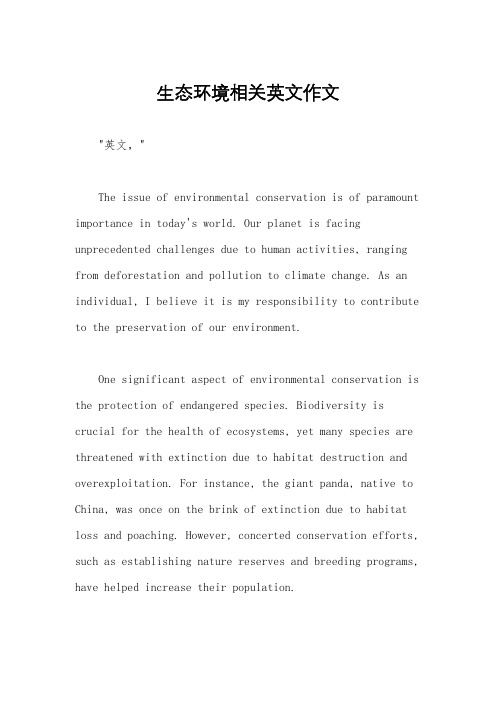
生态环境相关英文作文"英文,"The issue of environmental conservation is of paramount importance in today's world. Our planet is facing unprecedented challenges due to human activities, ranging from deforestation and pollution to climate change. As an individual, I believe it is my responsibility to contribute to the preservation of our environment.One significant aspect of environmental conservation is the protection of endangered species. Biodiversity is crucial for the health of ecosystems, yet many species are threatened with extinction due to habitat destruction and overexploitation. For instance, the giant panda, native to China, was once on the brink of extinction due to habitat loss and poaching. However, concerted conservation efforts, such as establishing nature reserves and breeding programs, have helped increase their population.Furthermore, reducing carbon emissions is essential to combatting climate change. Fossil fuel combustion is the primary driver of greenhouse gas emissions, leading to global warming and its associated impacts like extreme weather events and rising sea levels. Transitioning to renewable energy sources, such as solar and wind power, can significantly reduce our carbon footprint. Countries like Denmark have made remarkable progress in this regard, with wind energy accounting for a substantial portion of their electricity generation.Another crucial aspect is promoting sustainable practices in agriculture and industry. Intensive farming and industrial activities often lead to soil degradation, water pollution, and loss of biodiversity. Adopting sustainable farming methods like organic farming and agroforestry can help mitigate these negative impacts while ensuring food security. Additionally, implementing eco-friendly technologies and practices in industries, such as wastewater treatment and waste recycling, can minimize environmental pollution.In addition to individual actions, governmentalpolicies play a crucial role in environmental conservation. Governments can enact laws and regulations to limit pollution, protect natural habitats, and promote renewable energy development. For example, the European Union has implemented stringent regulations on air and water quality, driving industries to adopt cleaner technologies.Overall, addressing environmental challenges requires collective action at both individual and societal levels. By adopting sustainable practices, supporting conservation efforts, and advocating for policy changes, we can protect our planet for future generations."中文,"环境保护的问题在当今世界至关重要。
大海生态系统英语作文
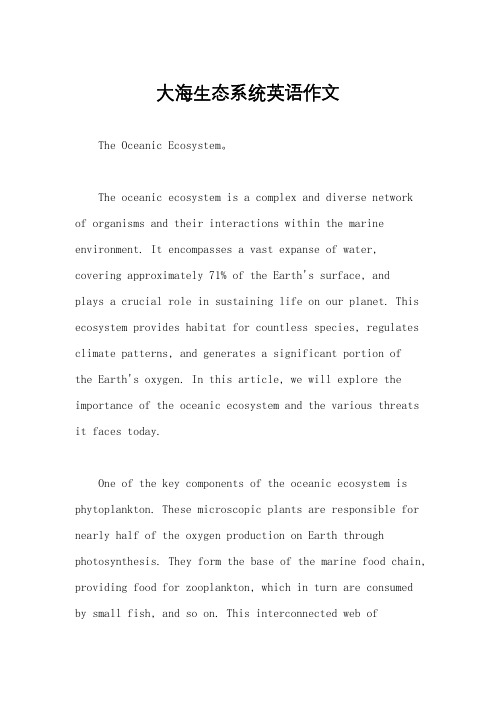
大海生态系统英语作文The Oceanic Ecosystem。
The oceanic ecosystem is a complex and diverse networkof organisms and their interactions within the marine environment. It encompasses a vast expanse of water, covering approximately 71% of the Earth's surface, andplays a crucial role in sustaining life on our planet. This ecosystem provides habitat for countless species, regulates climate patterns, and generates a significant portion ofthe Earth's oxygen. In this article, we will explore the importance of the oceanic ecosystem and the various threats it faces today.One of the key components of the oceanic ecosystem is phytoplankton. These microscopic plants are responsible for nearly half of the oxygen production on Earth through photosynthesis. They form the base of the marine food chain, providing food for zooplankton, which in turn are consumed by small fish, and so on. This interconnected web offeeding relationships is known as the marine food web, andit supports a wide range of marine life, from tiny organisms to large predators.The oceanic ecosystem is home to a diverse array of species, including fish, marine mammals, reptiles, and invertebrates. Coral reefs, for example, are among the most biologically diverse ecosystems on the planet, housing thousands of species. These vibrant and colorful underwater structures provide shelter, breeding grounds, and food sources for numerous organisms. However, coral reefs are highly sensitive to environmental changes, and they are currently facing significant threats such as coralbleaching due to rising sea temperatures and ocean acidification caused by increased carbon dioxide levels.Furthermore, the oceanic ecosystem plays a crucial role in regulating the Earth's climate. The ocean absorbs a significant amount of the sun's heat, helping to stabilize global temperatures. Additionally, it acts as a carbon sink, absorbing and storing large amounts of carbon dioxide from the atmosphere. However, human activities, such as theburning of fossil fuels and deforestation, have led to an increase in greenhouse gas emissions, resulting in climate change. This has had detrimental effects on the oceanic ecosystem, including rising sea levels, ocean acidification, and changes in ocean currents and weather patterns.Despite its immense importance, the oceanic ecosystemis facing numerous threats, primarily caused by human activities. Overfishing, for instance, has led to the depletion of fish stocks and disrupted the delicate balance of the marine food web. Unsustainable fishing practices, such as bottom trawling and drift nets, have also caused significant damage to marine habitats and ecosystems. Additionally, pollution from land-based sources, including plastic waste, oil spills, and chemical runoff, poses a significant threat to marine life, leading to habitat degradation and the death of countless organisms.Another major threat to the oceanic ecosystem ishabitat destruction, particularly the destruction ofcoastal habitats such as mangroves, seagrass beds, and salt marshes. These habitats provide essential breeding groundsand nurseries for many marine species. However, urban development, coastal erosion, and pollution have resultedin the destruction and degradation of these vital habitats. As a result, numerous species that depend on these habitats for survival are now at risk of extinction.To address these threats and protect the oceanic ecosystem, various conservation efforts are being implemented worldwide. Marine protected areas (MPAs) have been established to safeguard critical habitats and biodiversity hotspots. These protected areas restrict or regulate human activities, such as fishing and mining, to allow ecosystems to recover and thrive. Additionally, sustainable fishing practices, such as implementing catch limits and using selective fishing gear, are being promoted to ensure the long-term viability of fish stocks and the marine food web.Education and awareness also play a crucial role in protecting the oceanic ecosystem. By educating the public about the importance of the ocean and the threats it faces, individuals can make informed decisions and take actions toreduce their impact on the marine environment. Efforts to reduce plastic waste, promote sustainable seafood choices, and support organizations dedicated to ocean conservation are just a few examples of how individuals can contributeto the preservation of the oceanic ecosystem.In conclusion, the oceanic ecosystem is a vital component of our planet's health and well-being. Itsupports a diverse range of species, regulates climate patterns, and provides numerous ecosystem services. However, it is facing significant threats due to human activities, including overfishing, pollution, and habitat destruction. To ensure the long-term sustainability of the oceanic ecosystem, it is essential that we take collective actionto protect and conserve this invaluable resource. Byworking together, we can preserve the oceanic ecosystem for future generations and maintain the delicate balance oflife on Earth.。
关于环境的英语作文
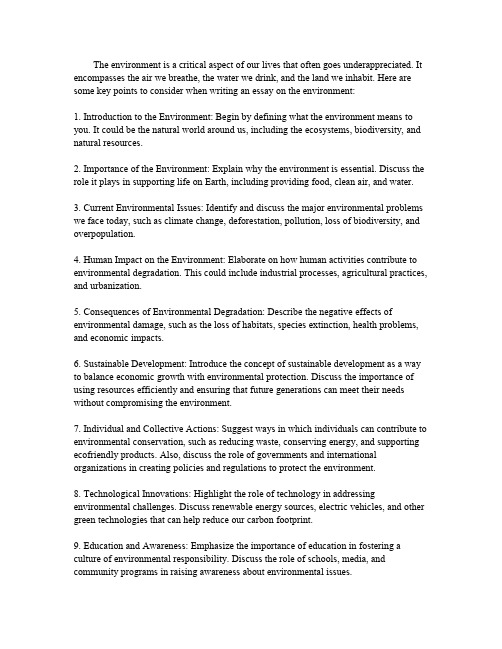
The environment is a critical aspect of our lives that often goes underappreciated.It encompasses the air we breathe,the water we drink,and the land we inhabit.Here are some key points to consider when writing an essay on the environment:1.Introduction to the Environment:Begin by defining what the environment means to you.It could be the natural world around us,including the ecosystems,biodiversity,and natural resources.2.Importance of the Environment:Explain why the environment is essential.Discuss the role it plays in supporting life on Earth,including providing food,clean air,and water.3.Current Environmental Issues:Identify and discuss the major environmental problems we face today,such as climate change,deforestation,pollution,loss of biodiversity,and overpopulation.4.Human Impact on the Environment:Elaborate on how human activities contribute to environmental degradation.This could include industrial processes,agricultural practices, and urbanization.5.Consequences of Environmental Degradation:Describe the negative effects of environmental damage,such as the loss of habitats,species extinction,health problems, and economic impacts.6.Sustainable Development:Introduce the concept of sustainable development as a way to balance economic growth with environmental protection.Discuss the importance of using resources efficiently and ensuring that future generations can meet their needs without compromising the environment.7.Individual and Collective Actions:Suggest ways in which individuals can contribute to environmental conservation,such as reducing waste,conserving energy,and supporting ecofriendly products.Also,discuss the role of governments and international organizations in creating policies and regulations to protect the environment.8.Technological Innovations:Highlight the role of technology in addressing environmental challenges.Discuss renewable energy sources,electric vehicles,and other green technologies that can help reduce our carbon footprint.cation and Awareness:Emphasize the importance of education in fostering a culture of environmental responsibility.Discuss the role of schools,media,and community programs in raising awareness about environmental issues.10.Conclusion:Summarize the main points of your essay and reiterate the urgency of environmental protection.End with a call to action,encouraging readers to take steps to contribute to a healthier planet.Remember to use clear,concise language and provide examples to support your arguments.Cite credible sources if you are using specific data or statistics.Writing an essay on the environment is an opportunity to express your concern for the planet and inspire others to take action.。
- 1、下载文档前请自行甄别文档内容的完整性,平台不提供额外的编辑、内容补充、找答案等附加服务。
- 2、"仅部分预览"的文档,不可在线预览部分如存在完整性等问题,可反馈申请退款(可完整预览的文档不适用该条件!)。
- 3、如文档侵犯您的权益,请联系客服反馈,我们会尽快为您处理(人工客服工作时间:9:00-18:30)。
The Inscape EnvironmentDewayne E. PerryAT&T Bell LaboratoriesMurray Hill, NJ 07974908.582.2529dep@published inThe 11th International Conference on Software EngineeringMay 1989, Pittsburgh PAAbstractThe Inscape Environment is an integrated software development enviroment for building large software systems by large groups of developers. It provides tools that are knowledgeable about the process of system construction and evolution and that work in symbiosis with the system builders and evolvers. These tools are integrated around the constructive use of formal module interface specifications. We first discuss the problems that Inscape addresses, outline our research strategies and approaches to solving these problems, and summarize the contributions of the Inscape Environment. We then discuss the major aspects of the Inscape Environment: the specification language, system construction, system evolution, use and reuse, and validation. We illustrate these various components with examples and discussions.Keywords:Integrated Software Development Environment; Formal Module Interface Specifications; Practical use of Formal Methods; Semantic Interconnection Model; City Model; Static Semantic Analysis; Environment-Assisted Construction and Evolution; Change Management; Version Management; Reuse.1. IntroductionThe Inscape Environment is an integrated software development environment for building large software systems by large groups of developers. The integration of the components in the environment occurs at two levels: at the lower level, they share a common internal representation (one typical meaning of the term ‘‘integrated environments’’) and a common user interface (another common meaning); at the higher level, the components are integrated around the constructive use of formal module interface specifications.Formal specification projects in general have emphasized the formal properties of specifications (as, for example, in Larch [8, 9]) and the problems of verification with respect to those specifications (as, for example, in the OBJ system [4, 5]). Little emphasis has been given to their practical use.1Guttag, Horning and Wing [7] state ‘‘We found it difficult to establish a useful correspondence between our elegant formal systems and the untidy realities of writing and maintaining programs’’. It is the thesis of this project that there is a useful correspondence between interface specifications and the untidy realities of writing and maintaining programs. Illustrating what we mean by ‘‘the constructive use of formal interface specifications’’ and its relationship to the ‘‘untidy realities of writing and maintaining programs’’ is the purpose of this paper.A slight digression first into the name of the project. The terms inscape and instress are taken from the poet Gerard Manley Hopkins because they are metaphorically suggestive. W. H. Gardner [2] statesAs a name for that ‘‘individually-distinctive’’ form . . . which constitutes the rich and revealing ‘‘one-ness’’ of a natural object, he coined the word inscape; and for that energy of being by which all things are upheld, for that natural . . . stress which determines an inscape and keeps it in being — for that he coined the word instress.As we are concerned with the form of programmed objects, it seems appropriate to call the environment Inscape; and as the environment is based on the premise that interface specifications provide the ‘‘glue’’ for programmed objects, the specification language is called Instress. For obvious reasons, the other components of Inscape all begin with the prefix ‘‘In’’.In the remainder of the introduction, we delineate the problems addressed by the Inscape Environment, the research strategies and approaches that we have taken in Inscape, and summarize the important research contributions made as part of our environmental research. We then discuss various aspects of the Inscape Environment: the module interface specification language, system construction, system evolution, use and reuse, and system validation. Finally, we present a short summary of the Inscape Environment.__________________1. An exception to this lack of practical application is Moriconi’s attempt in his Designer/Verifier’s Assistant [19] to provide ‘‘atechnique for identifying mechanically what formulas must be proved to determine the exact effects of change. This approach proved impractical because the formulas to be proved were in an undecidable theory, causing this problem to be no easier than the verification problem in general’’ [20]. Inscape embodies a similar conceptual framework, but attempts to overcome the practical shortcomings of Moriconi’s approach by a number of restrictions that are discussed subsequently in this paper.1.1 Problems AddressedInscape addresses two fundamental problems in building software systems: evolution and scale.Dividing the life-cycle into two distinct phases, development and maintenance, introduces a distinction that is not born out in practice. The entire life-cycle is iterative: requirements grow and evolve as understanding of the problem increases; the design evolves as design decisions constrain the solution space; these design decisions have backwards-reaching effects on the requirements, both from finding inconsistencies and lack of clarity as well as from indicating costs that may generate reconsideration of the requirements and changes to them; and so on throughout the remainder of the cycle. A system evolves in all its parts from beginning to end. Trying to force this evolutionary process into neat, distinct and independent phases only serves to obscure the reality of software development.In considering the problems of scale, there are several important subproblems: complexity, programming-in-the-large, and programming-in-the-many. How does one help to manage the problems of complexity, especially as the complexity of systems seems to explode with the increase in their size? What facilities are needed for building systems out of components that are separately developed? How do you manage the problems of ‘‘crowd control’’? What policies should be incorporated into the supporting environment to manage the interactions of the various individuals and groups doing a variety of different activities?These are the problems that we address in our research. The Inscape Environment is the context in which we explore solutions to these problems.1.2 Research Strategies and ApproachesThere are three basic approaches that we take in the Inscape Project: we formulate models of various parts of the system; we formalize parts of the process; and we explore various trade-offs to make intractable problems more manageable. Specifically, we•consider models of software interconnections [26] and propose a new model (semantic interconnections) that forms the underlying basis of Inscape;•develop a model of software development environments (SDEs) [28] to delineate the important aspects of SDEs and to characterize important aspects of SDEs with respect to the problems of scale;•formalize various aspects of the software process (specifically those of system construction and evolution);•make practical use of specification and verification technology by using formal interface specifications constructively; and•incorporate the understanding of specifications, the development process, and the programming language into the environment.Our research strategy is to proceed along several dimensions:•systematically work out the implications of using formal interface specifications as the integrating ingredient in a software development environment that supports the development of large systems witha large number of developers;•make the use of specifications practical — that is, ‘‘dance’’ around the ‘‘tarpit’’ of verification: restrict the power of the specification language; use shallow consistency checking (that tends towards pattern matching and simple deductions); and automate as much as possible, interacting with the user where automation is not possible;•use incremental techniques to distribute the cost of analysis — incremental in two senses: incrementally at a fine grain — for example, on a statement by statement basis interactively with the user; and incrementally on a large grain — because of the separation of interface and implementation, we can follow the intuition in Alphard [30], and analyze each implementation independently using interfaces as the basis for analysis.Our goal, then, is to provide a practical application of formal methods in building large, evolutionary software systems with large groups of people.1.3 Research Contributions of the Inscape EnvironmentThe novel features of the Inscape Environment are as follows:•introducing notions of obligations and multiple results in the interface language Instress;•using predicates as units of interconnection forming a semantic interconnection structure that is the basis for Inscape’s analysis;•enforcing the consistent use of interfaces, thereby detecting and preventing interface errors as they are made (within the constraints of Inscape’s shallow consistency checking);•determining the implications of changes to both interfaces and implementations at the levels of predicate satisfaction and propagation, and exception handling and propagation;•providing the policies of enforced and voluntary cooperation with supporting mechanisms (change propagation and simulation) and structures (hierarchical databases and workspaces);•supplementing the static analysis with specification-based test-case description generation and integration-test management;•using predicate-based browsing and system search techniques; and•formalizing various important version management concepts.The discussion of these various aspects of Inscape will clarify their contribution and their effect on the environment and the process of developing and evolving large systems.2. Module Interface SpecificationsThe primary purpose for using formal module interface specifications is to provide a means of presenting all the information that a programmer needs to know about using any particular module in a clear and concise way — that is, capturing what the designer had in mind when the module was created so that the module can be used in ways consistent with those intentions. To accomplish this purpose,Instress provides facilities for defining predicates and for describing the properties of data and the behavior of operations2(interms of these predicates). In addition, Instress provides facilities to supply kinds of pragmatic information (such as recommendations for recovery from exceptions). Thus, by specifying the semantics of the module interface and including pragmatic information, the designer can define precisely the meaning of a module and indicate ways in which it can be properly used.Our approach is based on that of Hoare’s input/output predicates [12] (see also [18, 30]) but extended in two ways: a set of obligations is added to the set of postconditions to form a result of an operation; and multiple results are provided to allow the description of both normal and exceptional exits from the operation. We use this predicate approach in Instress rather than an algebraic approach (see [4, 5, 6, 9]) because it seems better suited to specifying exceptions and obligations that may occur and what they mean when they do occur.3Further, we demonstrate below how this approach enables us to build a semantic interconnection structure that reflects the intent of the programmmer in building and evolving the system.The following specification of a file management module, Example 1, provides a sample of the type of specification that can be built in Instress. This example is used throughout the ensuing discussion to illustrate various aspects of Inscape and the uses that can be made of these kinds of specifications. In particular, this example illustrates the essential details about the module interface:•the vocabulary of the abstraction provided by the module,•the data objects and their properties,•relationships among data objects,•the operations and their effects and side-effects,•the interrelationships among different operations,•the interrelationships among operations and data,•exceptions and their effects, and•the minimal handling of exceptions.We first present the example, eliding details that are either repetitive or not essential to the subsequent discussion. Next, we discuss predicates and the logical language used to define them, data objects (types, constants, and variables), their definitions and descriptions, and then the specifications of operations (procedures and functions). Finally, we discuss various views of the specification and the analysis that Instress performs as the specification is built.__________________2. For the present, specifications are limited to sequential programs. This limitation is imposed to bound the problems that need to besolved. Given the method of describing the behavior of functions and procedures, it does not seem to be too great an extension to include concurrency of the form provided in either Ada [1] or Concurrent C [3] (since the notions of entries and transactions are analogous to functions and procedures, with additional semantics to cover aspects of concurrency).3. See [17] for a discussion of the relative strengths and weaknesses of various specification techniques.Please note that we have taken great pains to make the formality of the specifications accessible to the practicing programmer — that is, both easy to read and easy to understand while still having the necessary formal information.2.1 Example 1: The Specification of FileManagementThis view of the module specification is a sample of Instress’ publication view. Programming language entities are in constant-width font, semantic entities are in italics, and supplementary comments are in regular font._ ______________________________________________________________________________________*****Module FileManagement*****PredicatesLegalFileName(filename F)Definition:NonNullString(F) and each ( i in 1..length(F) ) { Alphabetic(F[i]) }Informally: A legal file name is a non-empty string of alphabetic characters only.FileExists(filename F) . . .ValidFilePtr(fileptr FP) . . .FileOpen(fileptr FP)Definition:primitiveInformally: The file is opened for reading and writing.FileClosed(fileptr FP)Definition:not FileOpen(FP)Informally: The file is closed for I/O.LegalRecordNr(int R) . . .RecordExists(int R) . . .RecordReadable(int R) . . .RecordConsistent(int R) . . .RecordWriteable(int R) . . .RecordIn(buffer B) . . .BufferSizeSufficient(buffer B; int R) . . .Data ObjectsType:filenameRepresentation:stringProperties:each ( filename F ) { LegalFileName(F) }Synopsis: A filename is a non-empty string that is limited to alphabetic characters.Type:fileptr. . .Operationsint CreateFile(<in> filename FN; <out> fileptr FP)Synopsis:CreateFile creates a file named by FN, automatically opens it, andreturns a handle to be used in all subsequent file operations until the fileis closed.Preconditions:LegalFileName(FN)<validated>not FileExists(FN)<validated>Results:<Successful result:CreateFile == 0>Synopsis: The file named by FN has been created and opened, and theoutput parameter FP is the handle for subsequent file operations.Postconditions:LegalFileName(FN) ValidFilePtr(FP)FileExists(FN) FileOpen(FP)Obligations:FileClosed(FP)<Exception IllegalFilename:CreateFile == 1>Synopsis: The file was not created because the file name in FN was invalidFailed:LegalFileName(FN)Postconditions:not LegalFileName(FN)Obligations:<none>Recovery: ensure that FN has an appropriate string<Exception FileAlreadyExists:CreateFile == 2>. . .int OpenFile(<in> filename FN; <out> fileptr FP). . .void CloseFile(<inout> fileptr FP)Synopsis:CloseFile closes the file and trashes the file pointer FPPreconditions:ValidFilePtr(FP)<assumed>FileOpen(FPf)<assumed>Results:<Successful result: assumed>Synopsis: assumes the file is open and FP is a valid file pointer;the file is closed and FP is no longer validPostconditions:FileClosed(FP) notValidFilePtr(FP’)Obligations:<none>int ReadRecord(<in> fileptr FP; <in> int R; <out> int L; <out> buffer B) . . .int WriteRecord(<in> fileptr FP; <in> int R; <in> int L; <inout> buffer B) Synopsis: . . .Preconditions:ValidFilePtr(FP)<assumed>FileOpen(FP)<assumed>LegalRecordNr(R)<validated>RecordIn(B)<assumed>Allocated(B)<validated>BufferSizeSufficient(B, L)<validated>RecordWriteable(R)<dependent>Results:<Successful result:WriteRecord == 0>Synopsis: The record R has been written in the file denoted by FPPostconditions:LegalRecordNr(R) Deallocated(B)BufferSizeSufficient(B,L) RecordExists(R)Obligations:<none><Exception IllegalRecordNr:WriteRecord == 1>Synopsis: An invalid record numberFailed:LegalRecordNumberPostconditions:not LegalRecordNrObligations:<none>Recovery: ...<Exception UnallocatedBuffer:WriteRecord == 2>. . .Postconditions:not Allocated(B). . .<Exception InsufficientBufferSize:WriteRecord == 3>. . .<Exception WriteError:WriteRecord == 4>Synopsis: The record has not been written due to an I/O errorFailed:RecordWriteable(R)Postconditions:LegalRecordNr(R) Allocated(B)BufferSizeSufficient(B, L) not RecordWriteable(R)Obligations:<none>Recovery:RecoverFileSystemboolean FileExists(<in> filename FN). . .Synopsis:FileExists determines whether the file named by FN exists.Preconditions:LegalFileName(FN)<assumed>Results:<Successful result:FileExists == TRUE>Synopsis: The file exists.Postconditions:FileExists(FN)Obligations:<none><Successful result:FileExists == FALSE>Synopsis: The file does not existPostconditions:not FileExists(FN)Obligations:<none>*****End FileManagement*****_ ______________________________________________________________________________________ Example 1: A sample Specification of FileManagement2.1.1 Predicate SpecificationsPredicate specifications are the means of creating the vocabulary necessary to describe the semantics of the data objects and operations in the module — that is, to express the abstraction provided by the module. The general intuition about predicates is that similar to the intuition of algorithmic abstraction: complex logical formulas are encapsulated in predicate definitions to provide a useful abstraction that is both easy to understand and easy to use. This abstractive and simplifying use of predicates is an important aspect of Inscape in trying to make formal methods and techniques available as a tool for the general programmer.In Example 1, we find illustrated the general form of predicate specifications: a typed predicate declaration with both formal and informal definitions. The informal definition is provided to aid the reader’s intuition about the formal definition. It is obvious that only the formal definition can be used by the analysis mechanisms, so that extreme care should be taken to ensure that the informal description exactly matches the formal one.The logical language of Instress is one of the primary focuses of our current research. The question is how to suitably restrict the language. One possibility is to restrict quantification to range over finite sets of data objects. For example, the definition of the predicate LegalFileName contains the quantified expression that describes a property of each character in the file name: each character must be alphabetic; no special characters are allowed. The quantification is limited to the characters in the file name.Some predicates are defined in terms of other predicates, either in the same module or in supporting modules. For example, the predicate BufferSizeSufficient would be declared by predicates defined in the memory management module. Some predicates, on the other hand, are introduced as primitive predicates, not because there is not an underlying definition, but because those details are abstracted from the interface and the user. The predicate FileOpen is such a predicate. The implementation meaning of the predicate denotes the installation of file details in main memory to make subsequent file operations more efficient. Those details are not relevant to the user. What is relevant, however, is that FileOpen and FileClosed are mutually contradictory predicates (see the definition of FileClosed). These definitional relationships and the subsequent use of the predicates in defining the properties of data objects and the behavior of operations build their meaning within the module interface.2.2 Data SpecificationsThere are three kinds of data objects to be found in module interfaces: types, constants, and shared variables. Type specifications define the basic meaning for data objects — that is, they define those properties that are common of all objects of that type. Intuitively, variables are used for particular purposes and have particular meaning in addition to that provided by the base type. Similarly, constants have a specific purpose to denote particular objects or values and, hence, have a specific meaning beyond that ofthe underlying type. This is the kind of information that the data object specifications are meant to capture.In Example 1, the type specification for filename illustrates only a subset of the kinds of information that might be specified for a type: the representation of the type (in terms of the programming language representation constructs), an informal description of the type (again, care should be taken that this informal part of the specification should be consistent with the formal part), and the formal properties of the type beyond those inherited from the type’s representation (for example, each object of type filename must satisfy the predicate LegalFileName in addition to satisfying the properties of the type string). These formal properties specify aspects of the type that are not expressible in the supported programming language, especially if the language has a weak or inexpressive type system (as, for example, C has). The designer may refine the meaning provided by the type’s representation as well as express relationships among data objects that are not expressible in a type system. Other aspects of interest in type specifications are initialization specifications with their resulting properties and obligations, and visibility or access restrictions (such as may be found, for example, in PIC [29]).Constant specifications define the value for the typed object and may refine the meaning of the type by specifying additional properties for that constant.Variable specifications define the type of the object, give an informal description of the intended meaning of the variable, and may specialize the type information by adding properties to refine the meaning associated with that particular variable and to express relationships with other data items. As with types specifications, initialization specifications, with their resulting properties and obligations, and visibility or access restrictions may be provided.2.3 Operation SpecificationsOperation specifications describe the abstract interface (that is, external) behavior of functions and procedures. In Instress, this interface behavior is described by a set of preconditions and a set of results. Results are divided into successful and exceptional results. For both sets, results are defined in terms of postconditions (predicates that are guaranteed to be true) and obligations (predicates that the user is entailed to satisfy eventually). For exceptional results, the specifier also supplies guidance about recovery with either an informal comment or a recommendations for a particular recovery routine. As in the previously discussed specification entities, formal descriptions are also provided by the specifier (with the attendant problems of maintaining consistency with the formal parts)We distinguish three kinds of preconditions:assumed, validated, and dependent preconditions.Assumed preconditions are those that Hoare [13] talks about when he says ‘‘if the assumptions are falsified, the product may break, and its subsequent (but not its previous) behavior may be wholly arbitrary. Even if it seems to work for a while, it is completely worthless, unreliable, and even dangerous.’’ These preconditions are assumed to be true and must be explicitly satisfied. In Example 1 in the specification of CloseFile, the designer has chosen to assume that the preconditions ValidFilePtr and FileOpen are true when the operation is invoked. This fact is expressed in the specification by the precondition annotation ‘‘<assumed>’’.However, when writing robust, fault-tolerant programs, there are some preconditions (i.e., assumptions) whose falsification leads to wholly predictable results. These are assumptions that are tested beforeproceeding in the implementation. We call these validated preconditions. In the specification of WriteRecord, the preconditions LegalRecordNr, Allocated, and BufferSizeSufficient, are validated first before proceeding to write the data to the file. The annotation ‘‘<validated>’’ indicates this status.Generally, validation is performed before committing to some computation that may be difficult or costly to undo. The choice between assuming or validating preconditions is often a tradeoff between safety and efficiency. On the other hand, assumed preconditions are often difficult or impossible to verify. In the case of the predicate RecordIn, however, it must be an assumed precondition as there is no way of determining, without detailed knowledge of the particular structure of the record, whether the user has put the desired data into the buffer or not.The third class of preconditions is that whose truth is not known until some point in the computation when an attempt is made do something, such as read a file. It is impossible to know whether the predicate RecordReadable is true until the hardware tries to read the record.Dependent preconditions are similar to validated preconditions but are dependent on, for example, external events, hardware, or other (concurrent) processes.We note that there is a special relationship between validated and dependent preconditions on the one hand and exceptions on the other: the failure of each validated and dependent precondition must be found in the specification of some exception. For examples see the exception specifications of CreateFile and WriteRecord.2.4 Instress ViewsOne of the primary benefits of using a prototyping mechanism such as the Gandalf’s ALOE editor-generation tools [11] is that one can experiment with various concrete syntax representations. The abstract syntax of the specifications can remain constant, but one can choose various ways in which to view the specification. Example 1 represents a multi-font, formatted, publication view. Other views available are an overview of the objects in the interface, an informal view of the objects (showing only the informal comments and synopses), a formal view (showing only the formal definitions of the objects), and various language-dependent views (such as internal and external views for C.hfiles).2.5 Instress AnalysisPart of the underlying support that Inscape provides the user is the formalization of the development process. In Instress, the process of specification has been formalized in a set of rules about consistency among various objects in the interface and rules about relationships among some of the interface objects. As the specification is built, Instress enforces various rules about consistency and rudimentary completeness. In particular, Instress checks that•predicate definitions are consistent;•precondition, postcondition and obligation lists are consistent;•validated and dependent preconditions are represented as failed conditions in at least one exception; and•<in>parameters have preconditions and<out>parameters have postconditions.。
